Women Composers
Vercoe - To Music - Flute Alone
 To Music, by Elizabeth Vercoe
To Music, by Elizabeth VercoeContemporary Composition for Solo Flute, PDF $6.99
Dr. Elizabeth Vercoe has been a composer at the St. Petersburg Music Festival in Russia, the Cité International des Arts in Paris, and the MacDowell Colony, and held the Acuff Chair of Excellence at Austin Peay State University in 2003. She has won many awards, commissions, and publications along with grants from the Artists Foundation and the National Endowment for the Arts. Her music is recorded on the Centaur, Capstone, Owl, Leonarda, and Parma labels and is published in print edition by Arsis Press.
To Music (2003) is a short, atmospheric solo for flute in four contrasting sections. At times the music is virtuosic, occasionally calling for multiphonics and other special effects. The titles of the four sections are taken from the haunting poetry of the Russian writer, Anna Akhmatova, a poet deeply interested in music.
Click to access a recording of To Music performed by flutist Peter H. Bloom in 2011 which has been posted on YouTube.
To Music can also be heard on the PARMA Recordings all-Vercoe CD
Preview Flute part, 5 pages; Total, 8 pages. titled Kleemation and Other Works byElizabeth Vercoe, which has received excellent critical reviews. Click to read an IAWM Journal review Dr. Laura G. Kafka or one by Lee Passarella published by Audiophile Audition magazine. "There's more poetic reference in To Music, the titles of whose four short sections are taken from Russian poet Anna Akhmatova's work. Like the Fantasy, it successfully showcases the colors and techniques available to the modern practitioner of her instrument, in this case the flute."
titled Kleemation and Other Works byElizabeth Vercoe, which has received excellent critical reviews. Click to read an IAWM Journal review Dr. Laura G. Kafka or one by Lee Passarella published by Audiophile Audition magazine. "There's more poetic reference in To Music, the titles of whose four short sections are taken from Russian poet Anna Akhmatova's work. Like the Fantasy, it successfully showcases the colors and techniques available to the modern practitioner of her instrument, in this case the flute."The image on our sheet music cover page displayed above is of Nathan Altman's 1914 painting, Portrait of Anna Akhmatova. Please note that this image, courtesy of Wikipedia, is public domain in the United States because it was first published before 1923 but it remains copyrighted in its source country. Therefore, we offer two editions of this publication, a USA edition with the Altman cover image and a non-USA edition without the cover image. The editions are otherwise identical.
 To Music was commissioned by flutist Lisa Vanarsdel and written for her and for the Laurels Flute Project. The piece was premiered in 2005 by flutist Peter Bloom on the Quincy Library concert series in Quincy, Massachusetts. In 2009 Capstone Records issued a recording entitled "Points of Entry" (CP 8806, second volume of the Laurels Flute Project) with flutist Nancy Stagnitta performing To Music.
To Music was commissioned by flutist Lisa Vanarsdel and written for her and for the Laurels Flute Project. The piece was premiered in 2005 by flutist Peter Bloom on the Quincy Library concert series in Quincy, Massachusetts. In 2009 Capstone Records issued a recording entitled "Points of Entry" (CP 8806, second volume of the Laurels Flute Project) with flutist Nancy Stagnitta performing To Music. Listen to a bit of To Music:
 mp3 tomusic
mp3 tomusic=============================================================================================
We also offer a print version of To Music, for those who prefer to purchase the piece as a professionally-printed hard copy. The price is $11.88 plus a $5.95 shipping and handling fee. Due to prohibitively high international shipping rates, we ship print editions only to addresses in the USA. Please use the Contact Us form to let us know which hard copy publication(s) you would like to purchase, along with your email contact information and USPS mailing address. We will then send you a PayPal invoice for the sale and, once we receive notice from PayPal that you have paid for the item(s), we will ship your music to the address provided.
Bauer – Sonata, Op.22 – Alto Saxophone
 Sonata, Op.22, by Marion Bauer
Sonata, Op.22, by Marion BauerTranscribed for Alto Saxophone (and piano) by Paul Cohen (originally for viola and piano)
Alto Saxophone Part, PDF $11.79
Paul Cohen is one of America's most sought-after saxophonists for orchestral and chamber concerts and solo recitals. In addition to being a renowned performer and recording artist, he is also a talented arranger, lecturer, and collector of rare and historical instruments. Dr. Cohen holds MM and DMA degrees from the Manhattan School of Music; he currently serves on the faculties of the Manhattan School of Music and Rutgers University. We at NSM were pleased for the opportunity to collaborate with him on this publication of his transcription of Marion Bauer’s Sonata for alto saxophone.
from Dr. Paul Cohen’s preface to the NSM edition © April 7, 2021:
“Bauer composed this sonata in 1932 or 1935. It originally was written for viola, and dedicated to the memory of her friend and colleague, Albert Stoessel who was a distinguished American violinist, conductor, author, composer, and educator in the 20th century. Bauer soon after created her own idiomatic transcription for clarinet and piano, and the sonata was published as a work for viola or clarinet in 1951. It is revealing to see the differences in the viola and clarinet versions. The piano part remains unchanged in both.
 There is a history of music for viola successfully adapted for saxophone by the composers. Fernande Decruck’s Sonata (1943) for saxophone and piano (or orchestra) was originally written for viola, as was Ross Lee Finney’s Sonata in A Minor from 1937 (viola and piano), adapted for saxophone in the early 1970s. Several works for alto saxophone and orchestra written for the American saxophonist Elise Hall were originally written for viola, including Florent Schmitt’s Legende (1918) and Choral Variee´ (1903) by Vincent D’Indy. Adolph Busch composed his Suite for violin and either viola or alto saxophone in 1926, while in 1923 Darius Milhaud replaced the viola with the saxophone in La Creation du Monde literally positioning the saxophone in the viola chair in the string section. My saxophone adaptation of Bauer’s Sonata combines elements of the clarinet and viola versions, creating a version appropriate for the alto saxophone. This includes changes in range, articulation, phrasing and dynamics to create an idiomatic (though challenging) version for the alto saxophone faithful to the musical intent of the composer.”
There is a history of music for viola successfully adapted for saxophone by the composers. Fernande Decruck’s Sonata (1943) for saxophone and piano (or orchestra) was originally written for viola, as was Ross Lee Finney’s Sonata in A Minor from 1937 (viola and piano), adapted for saxophone in the early 1970s. Several works for alto saxophone and orchestra written for the American saxophonist Elise Hall were originally written for viola, including Florent Schmitt’s Legende (1918) and Choral Variee´ (1903) by Vincent D’Indy. Adolph Busch composed his Suite for violin and either viola or alto saxophone in 1926, while in 1923 Darius Milhaud replaced the viola with the saxophone in La Creation du Monde literally positioning the saxophone in the viola chair in the string section. My saxophone adaptation of Bauer’s Sonata combines elements of the clarinet and viola versions, creating a version appropriate for the alto saxophone. This includes changes in range, articulation, phrasing and dynamics to create an idiomatic (though challenging) version for the alto saxophone faithful to the musical intent of the composer.”For additional information about Marion Bauer, please see the text excerpted from Peter H. Bloom’s preface to NSM’s 2014 publication of his transcription of the Sonata for alto flute.
We provide only the transcribed alto saxophone part in our edition; a pdf of the piano score is available from imslp.org.
Alto Saxophone Part, 11 pages; Total, 14 pages
PreviewGifford - The Pied Piper of Hamelin - An Operetta
 The Pied Piper of Hamelin, by Marjorie Otis Gifford
The Pied Piper of Hamelin, by Marjorie Otis GiffordAn Operetta, from the Poem by Robert Browning
Facsimile Edition by Noteworthy Sheet Music, LLC, PDF $24.99Marjorie Otis Gifford (1909-2003) was a composer, choirmaster, and long-time music and piano teacher in CT and NY. At age 24, she put music to Robert Browning's classic poem The Pied Piper of Hamelin, creating a children's operetta for her students. In her preface to the operetta, Mrs. Gifford states that perhaps the best performance of The Pied Piper was at the Lenox School in NYC, where she was teaching in 1938; that production was directed by Antoinette Perry, who later became known as 'Tony' of the Tony Awards. Indeed, there are additional famous personalities and much fascinating history associated with the remarkable life of Marjorie Otis Gifford.
The Pied Piper of Hamelin operetta was brought to NSM's attention by Gale Finlayson, daughter of composer and music educator Walter Finlayson, and we created our facsimile edition of the operetta at Gale's request. Marjorie Otis Gifford and Walter Finlayson were great friends, and in her preface Mrs. Gifford credits Mr. Finlayson with putting her operetta down on paper. NSM has received permission to publish the operetta from both the executor of Mrs. Gifford's estate and from Deborah O'Connor, the artist who created the charming illustrations that grace the internal pages of the operetta. We hope that, in publishing our facsimile edition, we can contribute to sustaining the legacy of Marjorie Otis Gifford and enabling future generations of young music students to perform and enjoy her work.
Marjorie Otis Gifford's The Pied Piper of Hamelin operetta was performed by the Rutland Youth Theatre of Rutland, VT, on March 2, 2018; click the link to visit YouTube and watch clips of this performance videotaped and posted by Ms. Finlayson.
Score with music and lyrics for voices and piano accompaniment, 67 pages; text of the Robert Browning poem addendum, 7 pages; Total, 78 pages.
PreviewPlease use the Contact Us link to order The Pied Piper of Hamelin operetta PDF. Upon receiving your request, we will send you an invoice via PayPal and, once PayPal acknowledges receiving your payment, we will email a copy of the PDF to you directly.
Vercoe - Fantavia - Flute & Percussion
 Fantavia, by Elizabeth Vercoe
Fantavia, by Elizabeth VercoeContemporary Composition for Flute and Percussion, PDF $12
Described by the New York Times as a piece with 'timbral adventures and lovely moments', Fantavia for flute and percussion is based on the rhythms and melodies of North American birdcalls. Some of the calls are as familiar as the orioles and robins of a suburban back yard, while others like the common loon are recollected on awakening at dawn in the wilderness. Although a literal transcription was the starting point for each call, the music is intended as a fantasy.

Fantavia has been performed at the Cité Internationale des Arts in Paris, at Merkin Hall in New York, at the National Flute Convention in Colorado and on several U.S. tours of the Armstrong Duo.
 The Duo recorded Fantavia on a Centaur compact disc entitled “Exotic Chamber Music” in 1996. Click to read a review published in the IAWM Journal.
The Duo recorded Fantavia on a Centaur compact disc entitled “Exotic Chamber Music” in 1996. Click to read a review published in the IAWM Journal. Click on the icons to hear audio samples.
 mp3 fantavialoon
mp3 fantavialoon  mp3 fantaviatrills
mp3 fantaviatrillsNamed by the Washington Post as 'one of the most inventive composers working in America today', Elizabeth Vercoe has had performances throughout the U.S. and abroad including: the St. Petersburg Spring Music Festival in Russia, the Goethe Institute in Bangkok, and the Pompidou Center in Paris as well as by the New York Virtuoso Singers and Boston Musica Viva.
Score for flute and percussion, 14 pages; Total, 17 pages.
Preview=========================================================
We also offer a printed hard copy edition of Fantavia for $20.40 plus a $5.95 shipping and handling fee. Due to prohibitively high international shipping rates, we ship print editions only to addresses in the USA. Please use the Contact Us form to let us know which hard copy publication(s) you would like to purchase, along with your email contact information and USPS mailing address. We will then send you a PayPal invoice for the sale and, once we receive notice from PayPal that you have paid for the item(s), we will ship your music to the address provided.
=========================================================
Vercoe – Kleemation – Flute & Piano
 Kleemation, by Elizabeth Vercoe
Kleemation, by Elizabeth VercoeOriginal Composition for Flute and Piano
Flute Part and Piano Score, PDF $16.95
Kleemation for flute and piano is in five short movements based on five drawings by Paul Klee titled: Goodbye to You, Please!, Afraid on the Beach, More Will Be Marching Soon, and Woman Sowing Weeds. Described as "highly abstract yet accessible," the piece was commissioned by Austin Peay University in Tennessee and received its premiere there in 2003. The New England premiere was at the Duxbury Art Museum in 2004 by the duo "2" (flutist Peter H. Bloom and pianist Mary Jane Rupert). "2" has since performed the piece on tours in the U.S., Thailand, Australia, and New Zealand. Click to read a testimonial to Elizabeth Vercoe's composition Kleemation written by Mr. Bloom.

Kleemation was recorded by "2" and can be heard on the PARMA Recordings all-Vercoe CD entitled Kleemation and Other Works by Elizabeth Vercoe. In an IAWM Journal CD review Dr. Laura G. Kafkawrites: “Vercoe musically renders Klee’s drawings with all the humor, fear, and reality that make each one leap from its canvas and dance.” Click to read Dr. Kafka’s full review. In another review published by Audiophile Audition magazine on September 26, 2013, Lee Passarella writes: "Vercoe (b. 1941) also shows a willingness to adapt different musical styles and elements to her basic idiom: the essential atonality of her music is leavened with some well-chosen pop influences where appropriate to the subject matter at hand. That includes Kleemation, a work based on drawings by Swiss modernist painter Paul Klee. Klee's sometimes whimsical, sometimes troubling art turns for its inspiration to the uninhibited world of the child artist."
Listen to an audio sample of Kleemation
 from the opening of the title piece.
from the opening of the title piece.Piano score, 27 pages; Flute part, 11 pages; Total, 44 pages; PDF $16.95.
PreviewFor those who would prefer to purchase a printed hard copy of this piece, rather than the PDF download offered here, our print edition of Kleemation for Flute and Piano by Elizabeth Vercoe is availabledirectly from NSM for $26.99 plus a $5.95 shipping and handling fee. Due to prohibitively high international shipping rates, we ship print editions only to addresses in the USA. Please use the Contact Us form to let us know which hard copy publication(s) you would like to purchase, along with your email contact information and USPS mailing address. We will then send you a PayPal invoice for the sale and, once we receive notice from PayPal that you have paid for the item(s), we will ship your music to the address provided.
Vercoe – Duos – Two Flutes
 Duos, by Elizabeth Vercoe
Duos, by Elizabeth VercoeOriginal Compositions for 2 Flutes, $0.00 (free!)
Elizabeth Vercoe's Duos for two flutes are available as free downloads from the composer's own website at http://www.elizabethvercoe.com/. Dr. Vercoe kindly offered to allow Noteworthy Sheet Music, LLC to make these duets available from our website as well. The Duos are "fun and quite easy. They are suitable for intermediate students."
Photo of Elizabeth Vercoe courtesy of Caroline Alden.
Just click on the links below to download the Duos at no charge:
Duos 1-5 for 2 flutesBeach - 3 Compositions - Alto Flute & Piano
 3 Compositions, Op.40, by Amy Beach
3 Compositions, Op.40, by Amy BeachTranscribed for Alto Flute and Piano by C.A.Vater
Piano Score and Alto Flute Part, PDF $10.50
Amy Marcy Cheney was born in Henniker, New Hampshire in 1867 and began composing music at the age of four. Initially home-schooled as a pianist, she continued her music studies in Boston and made her professional debut as a pianist at age 16. She later became a soloist with the Boston Symphony Orchestra. At 18, she married the prominent Boston physician Dr. Henry Harris Aubrey Beach and began using "Mrs. H. H. A. Beach" as her professional name. She continued to perform occasionally as a pianist, but for many years she focused her musical skills primarily on composing. After her husband's death in 1910, Mrs. Beach resumed her performing career, beginning with a three year tour of Europe, while also continuing to write music. Her works were received with great acclaim, and Amy Beach became one of America's leading composers and the first American woman composer to achieve widespread recognition in the United States and abroad. During her lifetime, she wrote more than 150 numbered works, spanning a variety of genres that included piano pieces, chamber music, orchestral works, sacred choral music, and a great many songs.
Amy Beach's 3 Compositions for Violin and Piano, Op.40, were first published in 1898. Written in the romantic style, the three pieces are (1) the beautiful but sombre La Captive, (2) a lovely, lyrical Berceuse, and (3) a lively but still tender Mazurka. In addition to alto flute transcriptions of all three pieces, we include in our edition a version of the Mazurka transcribed for flute and piano (score and part), for those wishing to give this option a try as well.
Alto Flute part, 4 pages; Piano/Alto Flute Score, 10 pages;
Alternate "Mazurka" Flute part, 2 pages; "Mazurka" Piano/Flute Score, 5 pages;
Total, 29 pages.
PreviewBauer - Sonata - Alto Flute
 Sonata, Op.22, by Marion Bauer
Sonata, Op.22, by Marion BauerTranscribed for Alto Flute by Peter H. Bloom (originally for viola)
Alto Flute Part, PDF $11.79
The following notes are excerpted, with permission, from the complete copyrighted foreword written by Peter H. Bloom for the Noteworthy Sheet Music edition of his transcription:
"The career of Marion Eugenie Bauer (1882-1955) as a composer, editor, writer, teacher, supportive colleague and mentor continues to assert a significant impact on the trajectory of American Music. It's mysterious that her legacy has been so rarely recalled and her music so infrequently performed in the six decades following her death. ... In 1906 she was the first of generations of American composers to study in Paris with the redoubtable Nadia Boulanger. ... We're fortunate that the composer crafted her own superb transcription of this sonata for clarinet and piano. In order to achieve the equivalent musical impact, her viola and clarinet versions differ in some places. The piano part, nevertheless, remains unchanged. Sometimes we've opted for the clarinet version, sometimes the viola version, and sometimes a conflation of the two. We have also made a few adaptive changes in tessitura, articulation, phrasing and dynamics to highlight the unique voice of the alto flute. Though execution may occasionally differ, the rhetorical and emotional shape of the work remains essentially the same."
P. H. Bloom, © January 7, 2014
We provide our alto flute transcription; the piano part is readily available as a free pdf download of the score from sources such as imslp.org/.
Alto Flute part, 9 pages of music; Total, 12 pages.
PreviewLi Qi - Fog - Flute Alone
 Fog, by Li Qi
Fog, by Li Qi
Contemporary Composition for Solo Flute, PDF $5.99Fog was written in 2012 by the up-and-coming young composer Li Qi. In addition to receiving other projects and awards, Li Qi was selected by the Wellesley Chamber Music Workshop to compose the program's commissioned piece for 2016, An Autumn Dusk in the Mountains for flute1, flute2/alto flute, cello, and piano.
Short, interesting, and challenging, Fog will appeal to advanced flutists and their audiences. Inspired by the poem "Stray Birds" by Rabindranath Tagore, the piece strives to capture in a musical way the recurring interplay between fog and sunlight, as a representation of the circle of life with all its sorrow, joy, and continuously-unfolding beauty. A recording of a 2012 performance of Fog by Heath White at the Jacobs School of Music, Indiana University, has been posted on YouTube; please click the link to listen.Our front cover image is from Wikimedia Commons: "The Mount Emei" by pookieevans (CC BY-SA 2.0).
Preview
Flute part, 3 pages; Total, 7 pages.Schumann, Clara - Three Romances - Alto Flute or Flute (and Piano)
 Three Romances, Op.22, by Clara Schumann
Three Romances, Op.22, by Clara SchumannTranscribed for Alto Flute or Flute (and Piano) by C.A.Vater
Alto Flute Part and alternative Flute Part, PDF $8.99
Clara Schumann’s Drei Romanzen für Pianoforte und Violine, Op. 22, were written in 1853 and dedicated to the Schumanns’ great friend, the famous Hungarian violin virtuoso Joseph Joachim, with whom Clara performed the Three Romances when they concertized together on tours across Europe. The Romances are lovely, short pieces; melodic and expressive, they epitomize the Romantic era and represent true chamber music in the sense that both instruments are featured comparably, rather than the piano having a merely accompaniment role. They are nicely adaptable to wind instruments, and are particularly lovely when played on alto flute. Our transcription required few modifications to bring the original violin part completely in range for alto flute and provide flute-friendly, musically-appropriate alternatives to the occasional violin double-stop. Some flutists may wish to mix and match the three movements, preferring to play one or two of the Romances on alto flute and the third on concert flute, or vice versa; so, to that end, we have included in this edition a complete alternative part adapted for C-flute. We do not provide a re-notated copy of the score, however, since high-quality PDFs of the piano and violin score are freely available in the public domain, and are easy to use along with our flute transcriptions of the violin line. To download one such PDF of the score, please visit the imslp website.
Alto Flute part, 5 pages; Flute part, 5 pages; Total 14 pages.
PreviewSchumann, Clara – Sechs Lieder - trans. for Alto Flute (and piano)
 Sechs Lieder, by Clara Schumann
Sechs Lieder, by Clara SchumannTranscribed for Alto Flute by C. A. Vater
Part for Alto Flute (in lieu of voice); PDF $5.99
In her Sechs Lieder, Op. 13, Clara Schumann set to music six German poems—two written by Heinrich Heine (Ich stand in dunklen Träumen and Sie liebten sich beide), three by Emanuel Geibel (Liebeszauber, Der Mond kommt still gegangen, and Die stille Lotosblume) and one by Friedrich Rückert (Ich hab’ in deinem Auge). Many of Clara Schumann’s songs were composed as gifts for her beloved husband Robert; they are romantic, melodic and highly expressive, and the Sechs Lieder of Op. 13 appropriately convey the broad array of intense emotions portrayed in the poetry that inspired them. These songs, which are absolutely charming, are nicely adaptable for a solo instrument in lieu of voice. They have been transcribed previously for violin or cello, and likely other instruments as well, but are particularly lovely when played on either alto flute or clarinet, instruments for which the voice line falls completely in range. Our Noteworthy Sheet Music editions of Op. 13 for alto flute or clarinet do not include re-notated versions of the score, since a high-quality PDF of the original piano and voice score is available free of charge in the public domain, and that piano accompaniment works perfectly well with our instrumental transcriptions of the voice line. The score we used when creating our parts may be downloaded from the IMSLP website. For NSM’s clarinet transcription of the Sechs Lieder voice line, please click the link.
Alto Flute Part, 4 pages; Total, 6 pages.
Preview
Schumann, Clara – Sechs Lieder - trans. for Clarinet (and piano)
 Sechs Lieder, by Clara Schumann
Sechs Lieder, by Clara SchumannTranscribed for Clarinet by C. A. Vater
Part for B-flat Clarinet (in lieu of voice); PDF $5.99
In her Sechs Lieder, Op. 13, Clara Schumann set to music six German poems—two written by Heinrich Heine (Ich stand in dunklen Träumen and Sie liebten sich beide), three by Emanuel Geibel (Liebeszauber, Der Mond kommt still gegangen, and Die stille Lotosblume) and one by Friedrich Rückert (Ich hab’ in deinem Auge). Many of Clara Schumann’s songs were composed as gifts for her beloved husband Robert; they are romantic, melodic and highly expressive, and the Sechs Lieder of Op. 13 appropriately convey the broad array of intense emotions portrayed in the poetry that inspired them. These songs, which are absolutely charming, are nicely adaptable for a solo instrument in lieu of voice. They have been transcribed previously for violin or cello, and likely other instruments as well, but are particularly lovely when played on either alto flute or clarinet, instruments for which the voice line falls completely in range. Our Noteworthy Sheet Music editions of Op. 13 for alto flute or clarinet do not include re-notated versions of the score, since a high-quality PDF of the original piano and voice score is available free of charge in the public domain, and that piano accompaniment works perfectly well with our instrumental transcriptions of the voice line. The score we used when creating our parts may be downloaded from the IMSLP website. For NSM’s alto flute transcription of the Sechs Lieder voice line, please click the link.
B-flat Clarinet Part, 4 pages; Total, 6 pages.
Preview
Vercoe - Butterfly Effects - Flute(s) and Harp
 Butterfly Effects, by Elizabeth Vercoe
Butterfly Effects, by Elizabeth VercoeContemporary Composition for Flute(s) and Harp
Flute Part and Harp Score, PDF $26.99
Butterfly Effects is an intriguing and varied piece in seven sections for flute and harp in which the flutist is asked to play bass, alto, piccolo and concert flutes. The titles are the names of butterflies: Mourningcloak, Banded Blue Pierrot, Common Jezebel, Question Mark, Monkey Puzzle, Karner Blues, and Psyche.
Excerpted from Elizabeth Vercoe's preface: "Butterfly Effects for flute and harp was written for the duo "2", with flutist Peter H. Bloom and harpist Mary Jane Rupert, who premiered the first parts of the piece in Bangkok and the entire work in Illinois in 2010. Along with the butterflies themselves, a quotation from Zhuangzi was the starting point for the music: "Am I a human who dreamt of being a butterfly or am I now a butterfly who dreams of being human?" The Taoist philosopher's dream illustrates, among other lessons, his sense of oneness with all living beings. // All seven movements are short, some only a minute in length. Mourningcloak, for alto flute and harp, is somber and reflective. Banded Blue Pierrot (concert flute) is short and glittering. Common Jezebel is a sultry tango for bass flute and harp that becomes increasingly chromatic and contrapuntal, requiring the harpist to do some fancy footwork. Question Mark, also for bass flute, requires the flutist to use "beat boxing" and key slap techniques that maximize the percussive qualities of the flute. Monkey Puzzle, in a kind of mimicry of the confusing antennae and pseudo antennae of the insect, flutters along to the middle of the piece and then proceeds backwards to the beginning in what is known as retrograde motion. Karner Blues adopts some of the riffs of blues instrumentalists and singers in the only movement for piccolo. Psyche, a word meaning breath or soul in Greek, is for concert flute and reminds us again of the Zhuangzi dream and the oneness of all living beings."
Butterfly Effects may be performed by one flutist playing multiple instruments, or by multiple flutists each playing one instrument for the relevant movement(s).
Our striking cover image for this publication is of the painting "Jezebel Tapestry #2" by Louisa King Fraser, used with the artist's permission.
Butterfly Effects for flute(s) and harp received a rave review by Nicole Riner in the Fall 2015 edition of the National Flute Association’s membership magazine The Flutist Quarterly. Read the review in its entirety reprinted on the NSM website with permission from the NFA, or visit the NFA website.
Click to view a YouTube video of the duo "2" performing Banded Blue Pierrot.
Peter H. Bloom gave a lecture on “Effective Writing for Flutes and the Contemporary Flutist” at the 2018 Snow Pond Composers Workshop. In his presentation, Mr. Bloom discussed various topics using four contemporary works published by Noteworthy Sheet Music, including Butterfly Effects, as examples. We later published a free text version of this excellent presentation on our website, in the Reviews and Articles section, including some of the audio clips and supplemental written materials that Mr. Bloom used as demonstrations.
 The Elizabeth Vercoe CD "Butterfly Effects and Other Works" was released in November 2018. The CD is available through Navona Records and features the title track performed by duo "2". Here is a quote from Cinemusical's review of the CD: "The album opens with a multi-movement work for flutes and harp, Butterfly Effects (2009). Across the seven movements, Vercoe explores the qualities of different instruments in the flute family: alto flute, bass flute, concert flute, and piccolo. The music has a slight impressionistic quality to it, aided by the harp’s material. Against this is first a rather dreamy, dark opening movement (“Mourningcloak”); a faster-paced flitting “Banded Blue Parrot”; a tango (“Common Jezebel”); intriguing effects like beat-boxing (“Question Mark”) and blues riffs (“Karner Blues”); and a palindromic compositional technique (“Monkey Puzzle”). The flute lines allow for registral exploration and often features some sinuous lines. Some are sultrier than others, but it is as if these are all like watercolor brushstrokes that tend to be somewhat introspective in this often stunningly beautiful work." Another nice review of this CD, written by Nicole Riner, came out in the Flutist Quarterly Spring 2019 edition; here's a quote: "I had the pleasure of reviewing the sheet music for Butterfly Effects for this publication in 2015 and found it to be wonderfully diverse and intriguing. /// Bloom and Rupert perform this work deftly and with a great sense of unity”.
The Elizabeth Vercoe CD "Butterfly Effects and Other Works" was released in November 2018. The CD is available through Navona Records and features the title track performed by duo "2". Here is a quote from Cinemusical's review of the CD: "The album opens with a multi-movement work for flutes and harp, Butterfly Effects (2009). Across the seven movements, Vercoe explores the qualities of different instruments in the flute family: alto flute, bass flute, concert flute, and piccolo. The music has a slight impressionistic quality to it, aided by the harp’s material. Against this is first a rather dreamy, dark opening movement (“Mourningcloak”); a faster-paced flitting “Banded Blue Parrot”; a tango (“Common Jezebel”); intriguing effects like beat-boxing (“Question Mark”) and blues riffs (“Karner Blues”); and a palindromic compositional technique (“Monkey Puzzle”). The flute lines allow for registral exploration and often features some sinuous lines. Some are sultrier than others, but it is as if these are all like watercolor brushstrokes that tend to be somewhat introspective in this often stunningly beautiful work." Another nice review of this CD, written by Nicole Riner, came out in the Flutist Quarterly Spring 2019 edition; here's a quote: "I had the pleasure of reviewing the sheet music for Butterfly Effects for this publication in 2015 and found it to be wonderfully diverse and intriguing. /// Bloom and Rupert perform this work deftly and with a great sense of unity”.Flute part, 16 pages; Harp Score, 43 pages; Total, 66 pages.
Preview=========================================================
We also offer a printed hard copy edition of Butterfly Effects for $45.88 plus a $5.95 shipping and handling fee. Due to prohibitively high international shipping rates, we ship print editions only to addresses in the USA. Please use the Contact Us form to let us know which hard copy publication(s) you would like to purchase, along with your email contact information and USPS mailing address. We will then send you a PayPal invoice for the sale and, once we receive notice from PayPal that you have paid for the item(s), we will ship your music to the address provided.
=========================================================
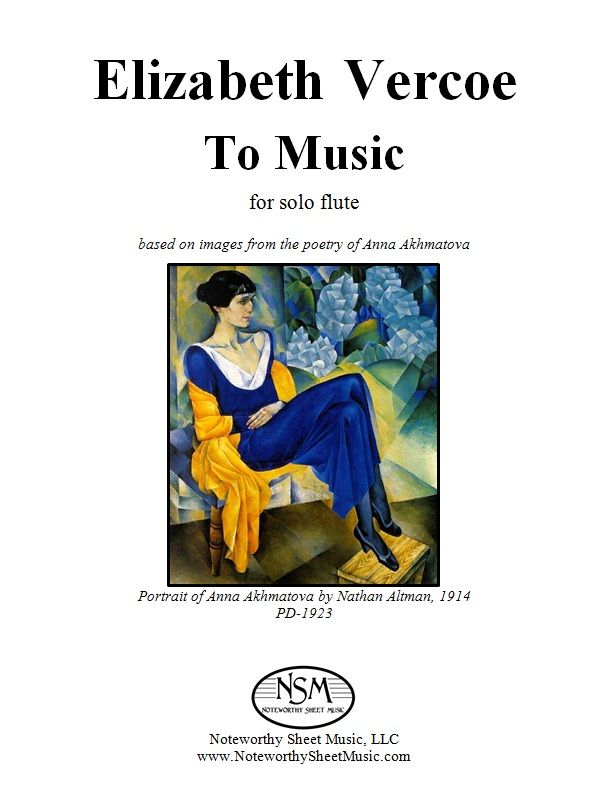 To Music, by Elizabeth Vercoe
To Music, by Elizabeth Vercoe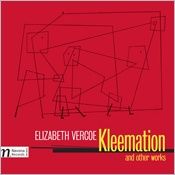 titled
titled 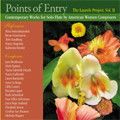
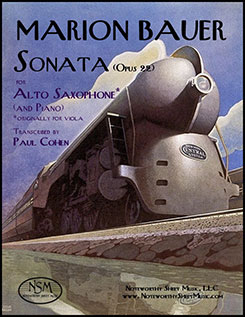
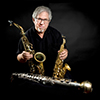 There is a history of music for viola successfully adapted for saxophone by the composers. Fernande Decruck’s Sonata (1943) for saxophone and piano (or orchestra) was originally written for viola, as was Ross Lee Finney’s Sonata in A Minor from 1937 (viola and piano), adapted for saxophone in the early 1970s. Several works for alto saxophone and orchestra written for the American saxophonist Elise Hall were originally written for viola, including Florent Schmitt’s Legende (1918) and Choral Variee´ (1903) by Vincent D’Indy. Adolph Busch composed his Suite for violin and either viola or alto saxophone in 1926, while in 1923 Darius Milhaud replaced the viola with the saxophone in La Creation du Monde literally positioning the saxophone in the viola chair in the string section. My saxophone adaptation of Bauer’s Sonata combines elements of the clarinet and viola versions, creating a version appropriate for the alto saxophone. This includes changes in range, articulation, phrasing and dynamics to create an idiomatic (though challenging) version for the alto saxophone faithful to the musical intent of the composer.”
There is a history of music for viola successfully adapted for saxophone by the composers. Fernande Decruck’s Sonata (1943) for saxophone and piano (or orchestra) was originally written for viola, as was Ross Lee Finney’s Sonata in A Minor from 1937 (viola and piano), adapted for saxophone in the early 1970s. Several works for alto saxophone and orchestra written for the American saxophonist Elise Hall were originally written for viola, including Florent Schmitt’s Legende (1918) and Choral Variee´ (1903) by Vincent D’Indy. Adolph Busch composed his Suite for violin and either viola or alto saxophone in 1926, while in 1923 Darius Milhaud replaced the viola with the saxophone in La Creation du Monde literally positioning the saxophone in the viola chair in the string section. My saxophone adaptation of Bauer’s Sonata combines elements of the clarinet and viola versions, creating a version appropriate for the alto saxophone. This includes changes in range, articulation, phrasing and dynamics to create an idiomatic (though challenging) version for the alto saxophone faithful to the musical intent of the composer.”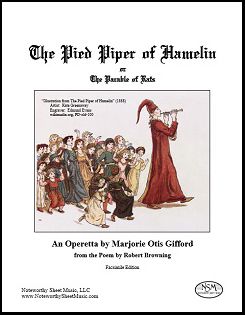 The Pied Piper of Hamelin, by Marjorie Otis Gifford
The Pied Piper of Hamelin, by Marjorie Otis Gifford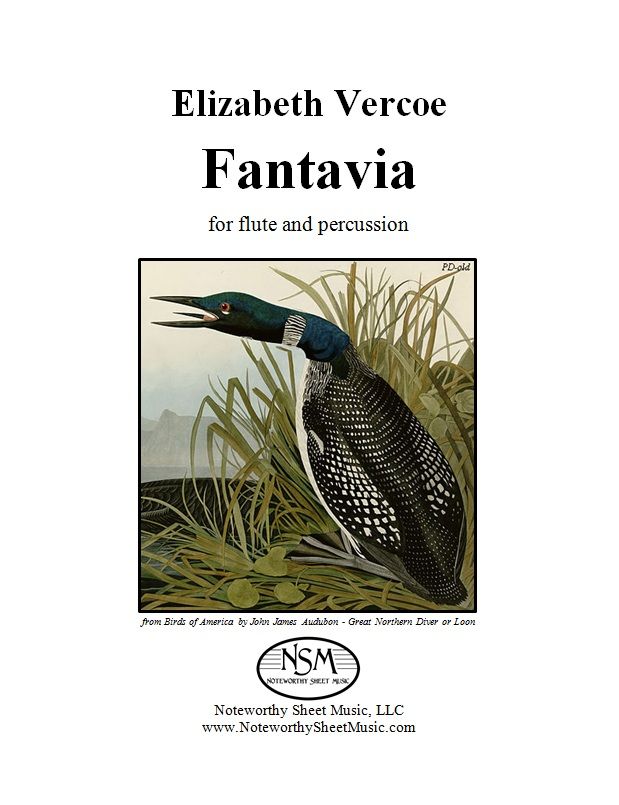 Fantavia, by Elizabeth Vercoe
Fantavia, by Elizabeth Vercoe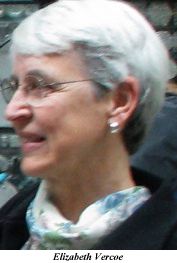
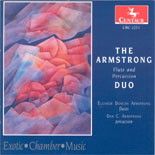 The Duo recorded Fantavia on a Centaur compact disc entitled “
The Duo recorded Fantavia on a Centaur compact disc entitled “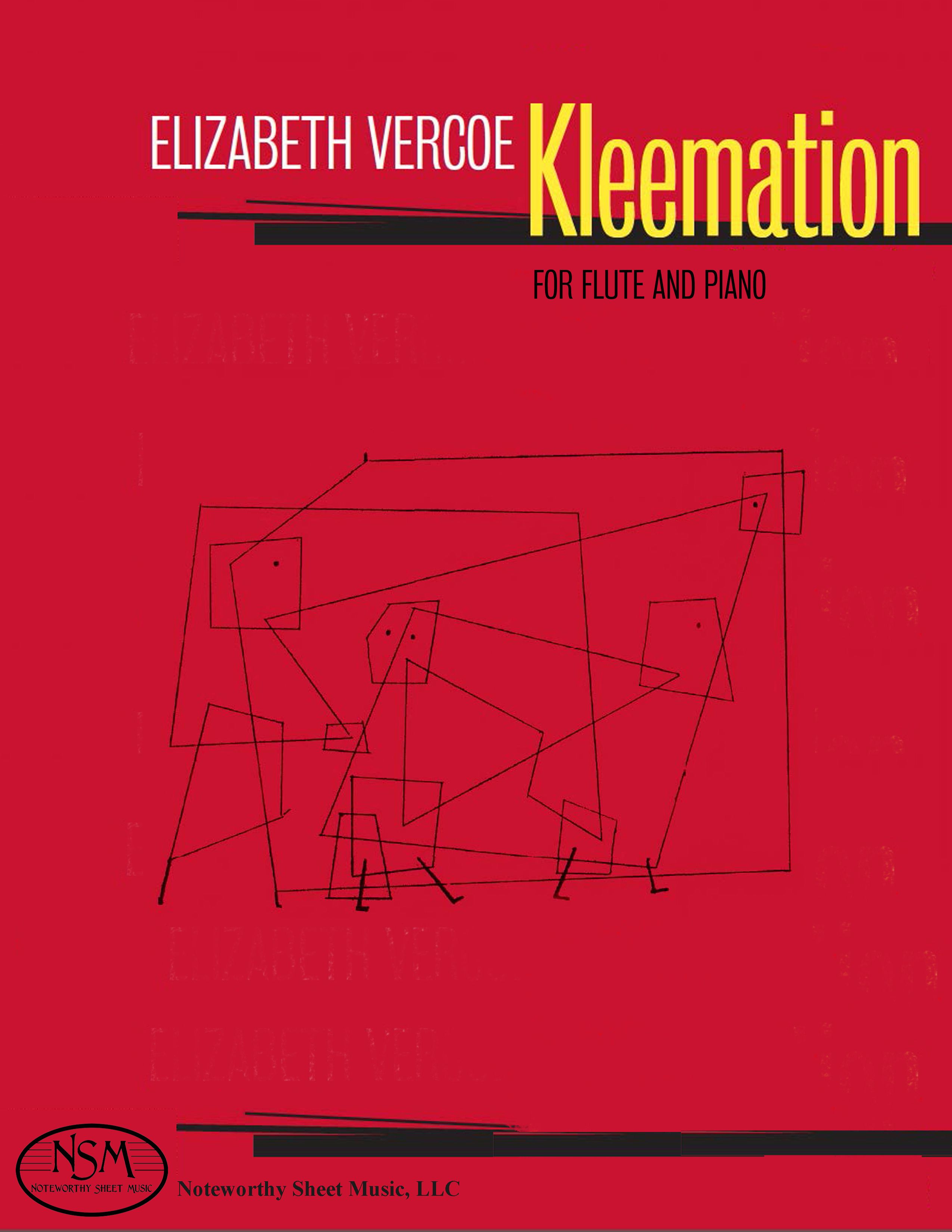 Kleemation, by Elizabeth Vercoe
Kleemation, by Elizabeth Vercoe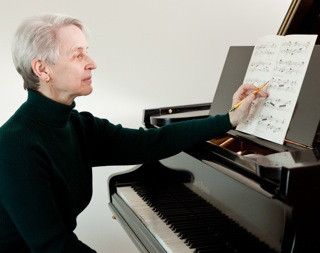 Duos, by Elizabeth Vercoe
Duos, by Elizabeth Vercoe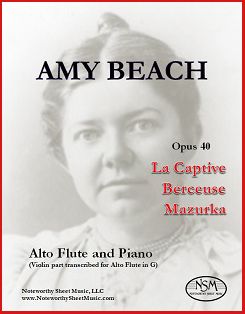 3 Compositions, Op.40, by Amy Beach
3 Compositions, Op.40, by Amy Beach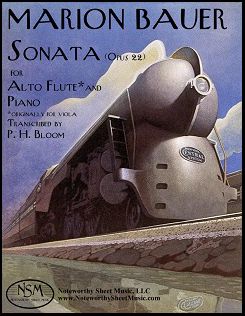 Sonata, Op.22, by Marion Bauer
Sonata, Op.22, by Marion Bauer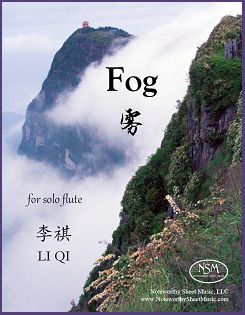 Fog, by Li Qi
Fog, by Li Qi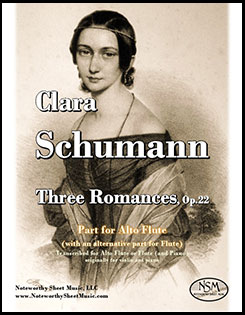 Three Romances, Op.22, by Clara Schumann
Three Romances, Op.22, by Clara Schumann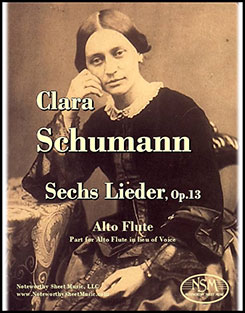 Sechs Lieder, by Clara Schumann
Sechs Lieder, by Clara Schumann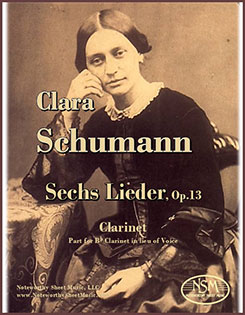 Sechs Lieder, by Clara Schumann
Sechs Lieder, by Clara Schumann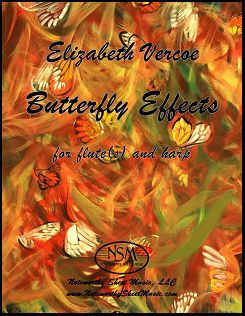 Butterfly Effects, by Elizabeth Vercoe
Butterfly Effects, by Elizabeth Vercoe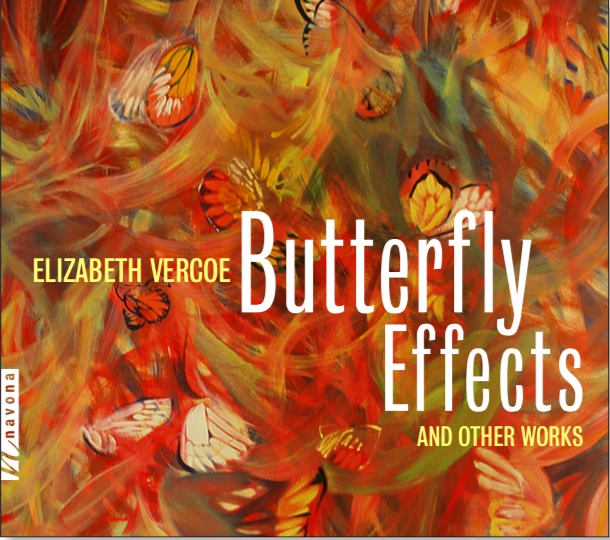 The Elizabeth Vercoe CD "Butterfly Effects and Other Works" was released in November 2018. The CD is available through
The Elizabeth Vercoe CD "Butterfly Effects and Other Works" was released in November 2018. The CD is available through